Fats Found in Beef Lamb and Butter Contain High Amounts of
Unsaturated fats are a wide category of fatty acids we consume in our diets. Although they are commonly known as "healthy fats," some unsaturated fats tin can actually worsen our health.
In fact, unsaturated fatty acids represent each end of the health spectrum, from completely toxic trans fats to polyunsaturated and monounsaturated fats that help support optimal health and longevity.
To better understand this complicated category of fats, permit'due south take a expect at unsaturated fatty acids from the post-obit perspectives:
- What is unsaturated fat? The dietary definition
- What is unsaturated fat? From a biochemical perspective
- Unsaturated fatty acid examples
- Saturated vs. unsaturated fatty: what is the departure?
- Health benefits of unsaturated fatty acids
- Unsaturated fat food list
- Healthy unsaturated fat recipes
- How much unsaturated fat should we consume?
- The potential harms of unsaturated fatty acids
- Practical takeaways
What is Unsaturated Fat? The Dietary Definition
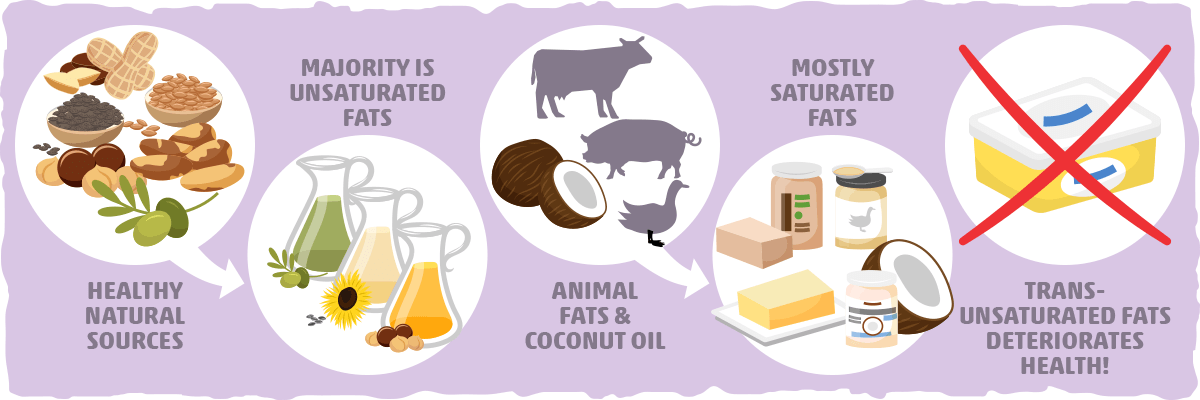
Vegetables, legumes, nuts, seeds, and the oils derived from these foods more often than not consist of unsaturated fats. In full general, if a cooking oil is liquid at room temperature, the majority of its fatty content will be unsaturated.
In dissimilarity, animal fats and coconut oil tend to be solid at room temperature because they are mostly made upwardly of saturated fats.
This simple deviation in concrete properties likewise reflects the varying impacts each type of fat can have on our health. Unsaturated fats are typically regarded every bit healthy fats because they improve various biomarkers of wellness more effectively than saturated fat, which tends to improve certain biomarkers (east.g., by raising HDL cholesterol levels) and may worsen others (e.thousand., past increasing LDL cholesterol levels).
Most unsaturated fats follow this general pattern. One time they are processed into trans unsaturated fats, even so, we finish upwards with a completely different story.
Artificial trans fats, for example, are processed in such a way that it makes polyunsaturated fats solid at room temperature and lengthens their shelf life.
This rapid shift in physical properties is indicative of how information technology changes the health event of the fat – completely transforming what was once a healthy fat into a type of trans-unsaturated fat that rapidly deteriorates our cardiovascular health.
To develop a better understanding of why unsaturated fats are like this, we must take a look at them through a microscope.
What is Unsaturated Fat? From a Biochemical Perspective
The technical definition of unsaturated fatty is a fatty acrid in which in that location is at to the lowest degree one double bail in the carbon chain. Nevertheless, since virtually of the fat we eat consists of long-chain fats with fourteen or more carbons, this simple classification leaves a lot to the imagination.
Take a look these unsaturated fat acids for case:
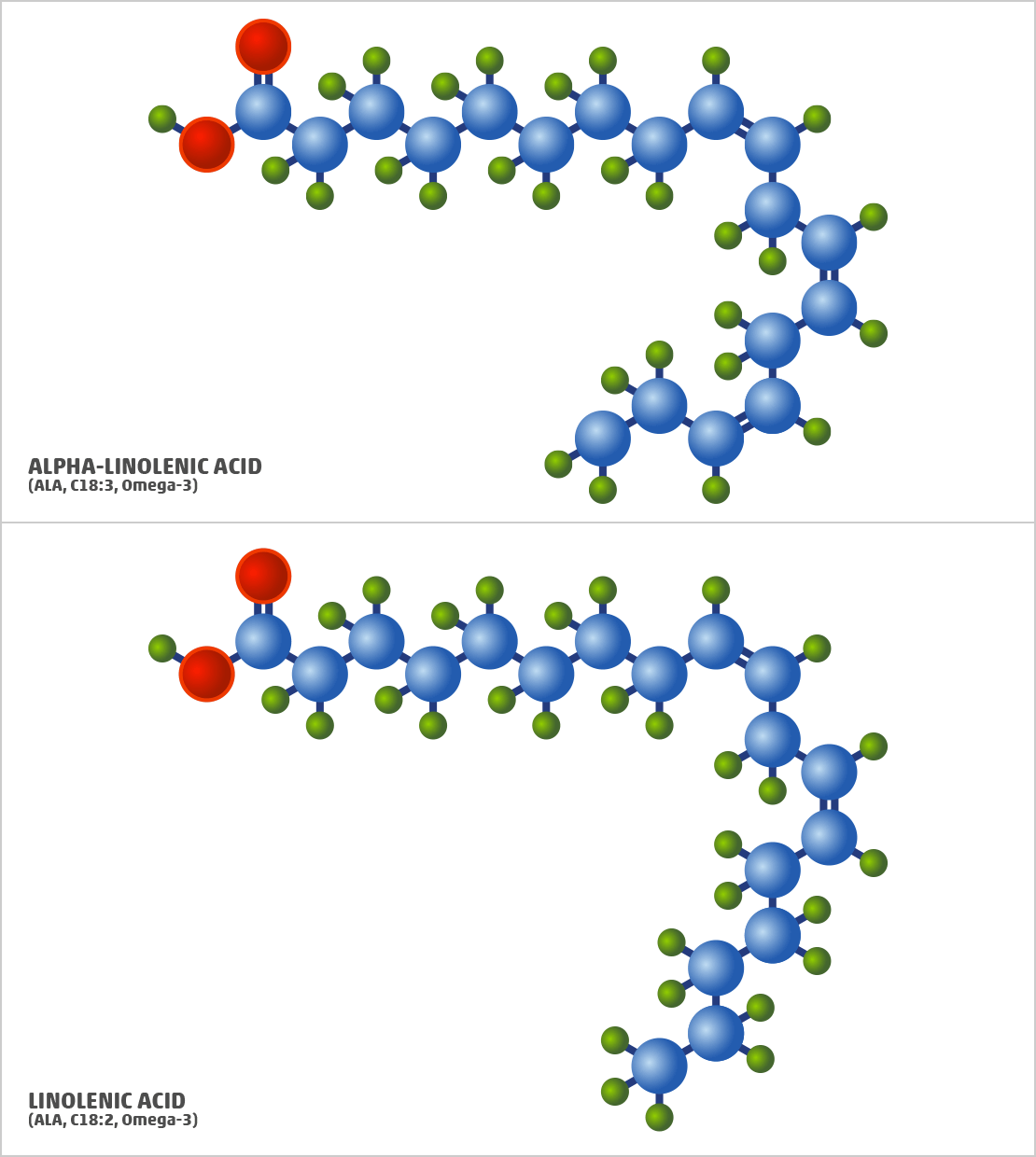
Each i is an essential fatty acid that we must become from our diets for optimal health. An actress double bond hither, a modified double bond location at that place, and we are left with two entirely different fatty acids that are used by our bodies in entirely different ways.
This instance helps us highlight the potential for endless iterations of unsaturated fatty acids. This is why information technology is helpful to break them downwards into two categories:
- Monounsaturated fats (MUFAs)
- Polyunsaturated fats (PUFAs)
A fatty acid is monounsaturated if it contains one double bond, and polyunsaturated if information technology contains more than than one double bond.
This simple difference in chemical construction leads to a meaning modify in how our body metabolizes information technology and how information technology affects our health.
Another variation worth noting is the double bond blazon. PUFAs and MUFAs comprise exclusively cis-double bonds. The "cis" tells us that the hydrogen atoms that are attached to the double-bonded carbon atoms are found on the same side of the fatty acid chain.

After these cis-unsaturated fatty acids are processed – artificially via partial hydrogenation or naturally in a ruminant'southward stomach – they tin become trans-unsaturated fatty acids (ordinarily known every bit trans fats). The "trans" indicates that the hydrogen atoms attached to the double-bonded carbon are now on the contrary side of the fatty acid chain.
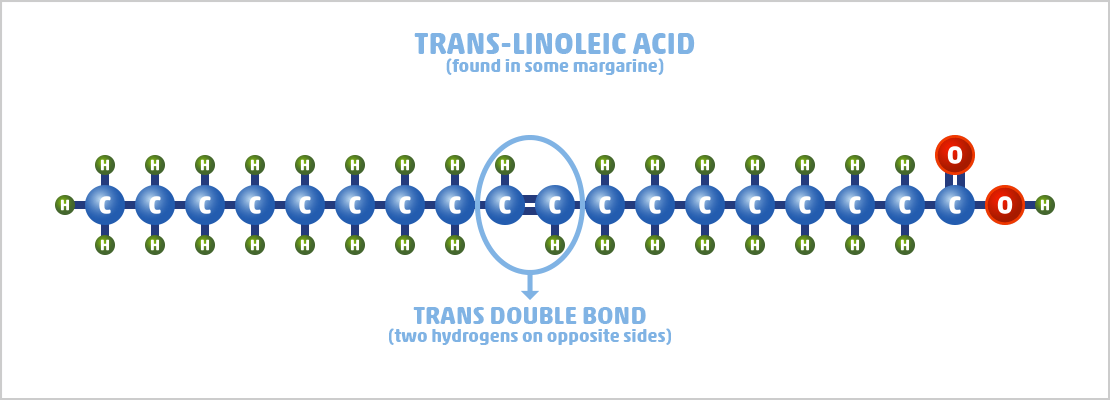
Natural and bogus processing atomic number 82 to singled-out differences in how many cis-bonds they change. This translates to contrasting health effects between natural trans fats and artificial trans fats as well.
Long story short, unsaturated fat is a fatty acrid with at least one carbon-carbon double bond in its carbon concatenation. The number, location, and type of these double bonds all vary in specific ways that are encapsulated in the four main types of unsaturated fatty acids:
- Monounsaturated fats – a fat acid that contains only i carbon-carbon double bond
- Polyunsaturated fats – a fatty acrid that includes more than one carbon-carbon double bond
- Natural trans-unsaturated fats – a fatty acrid with at least i trans-double bail and one cis-double bond that is formed naturally in a ruminant'due south stomach.
- Artificial trans-unsaturated fats – a fatty acid with no cis-double bonds and at least i trans-double bond that is formed artificially through a procedure called hydrogenation.
Let'south take a look at some examples of each unsaturated fatty to add together some colour to these fundamental concepts.
Unsaturated Fatty Acrid Types with Examples
The four types of unsaturated fat contain a plethora of different fatty acids that vary in length, double bond location, double bond amount, and/or double bond types. Below you'll find examples of each type of unsaturated fat and common foods they are found in.
Monounsaturated Fat Examples
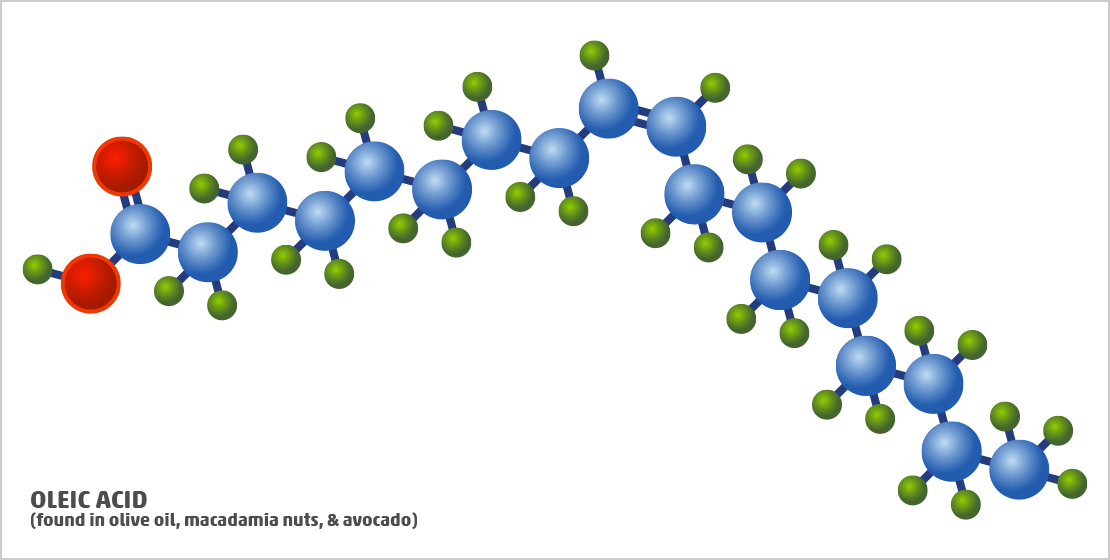
The most mutual monounsaturated fatty you'll consume is oleic acid. In fact, it is the most widely distributed and abundant fatty acrid in nature.
Olive oil, macadamia nuts, and avocado are the best sources of this monounsaturated fatty acrid, which is responsible for many of the wellness benefits these foods tin can provide us.
Polyunsaturated Fat Examples
Polyunsaturated fats are consumed as either omega-half dozen or omega-3 fatty acids, which differ in where their get-go double bail is found from the end of the carbon chain (i.e., from the methyl grouping).
Linoleic acid (an omega-6 fatty acid) and α-linolenic acid (an omega-3 fatty acid) are ii commonly consumed PUFAs. They are as well known every bit essential fat acids because we cannot synthesize them.
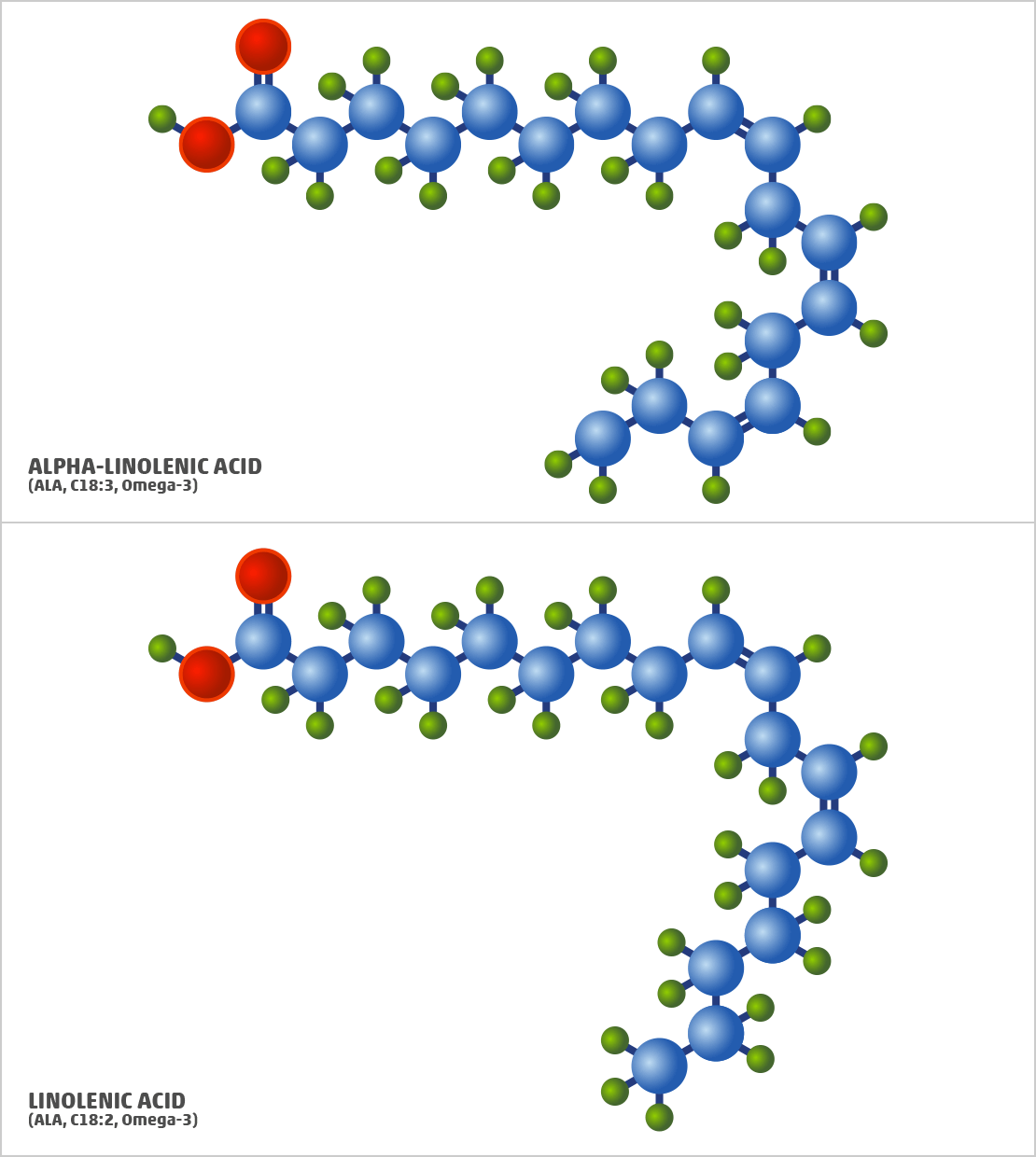
You will observe polyunsaturated fats in all constitute and animal foods. Linoleic acrid is plant in higher quantities in nuts, seeds, and vegetable oils, while the best sources of α-linolenic acid are flaxseeds, chia seeds, walnuts, and hemp seeds.
Natural Trans-unsaturated Fat Examples
Natural trans fats are also known equally conjugated linoleic acids (CLA). CLA represents a group of trans fats that are naturally formed during the procedure of linoleic acrid digestion in ruminants.
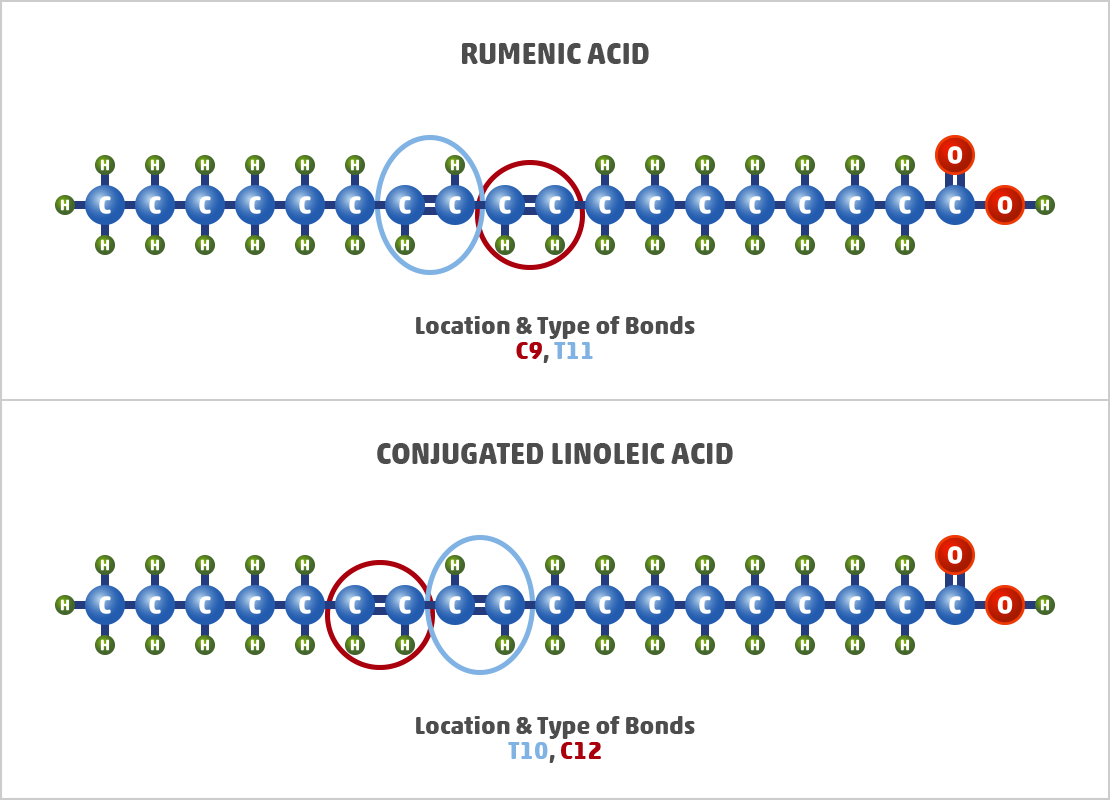
Equally yous can meet, these fats have both trans and cis double bonds in their carbon chains. This is why we refer to these fatty acids as being "conjugated."
These trans fats typically brand up ii-5% of the fat in dairy products and 3-ix% of the fat in beef and lamb. I of the most common types of CLA found in these foods is known as rumenic acrid (the c9, t11 CLA pictured to a higher place).
Research indicates that CLA may accept some benefits. The same cannot be said for artificially-produced trans fats.
Artificial Trans-unsaturated Fat Examples
Although natural and artificial trans fats both autumn under the same "trans fat" category, they take different chemic structures and vastly dissimilar effects on our health.
Artificial trans fats are developed via a process called hydrogenation. This leads to the cosmos of non-conjugated trans-linoleic acid (i.due east., it no longer has a cis-double bond).
Hither'south an instance of what happens when nosotros partially hydrogenate vegetable oils:
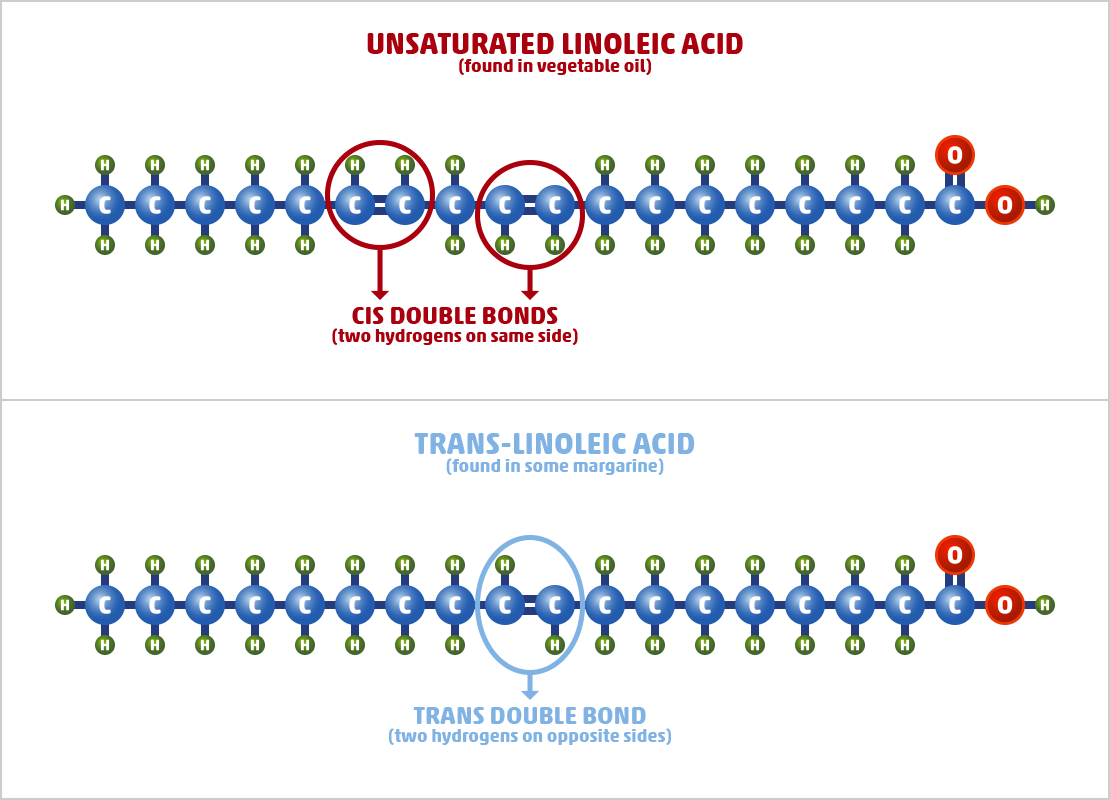
What was previously an essential omega-6 fatty acid with multiple cis-double bonds (i.e., linoleic acrid) volition lose its cis-double bonds and gain a trans-double bond. In other words, the artificial process of hydrogenation transforms what was one time a healthy fat into a toxic version of trans fat.
You'll find these harmful fats in margarine and any product that contains a partially hydrogenated oil (even if the characterization says information technology has 0 grams of trans fatty).
Saturated vs. Unsaturated Fat: What is the Difference?
Although unsaturated fatty acids make upward a large portion of the fatty in our diets, we cannot forget nigh saturated fatty. Knowing the deviation between the ii is crucial to our agreement of salubrious fat intake.
Deciphering between saturated fatty and unsaturated fat is relatively simple. Unsaturated fats have at least i carbon-carbon double bond while saturated fats have only carbon-carbon single bonds.

Put in another way, saturated fats are "saturated" with hydrogen atoms, while unsaturated fats do not have the maximum amount of hydrogen atoms a fatty acid can take, making them "unsaturated."
Another mode of remembering the difference is that saturated fats are "saturated" in unmarried carbon-to-carbon bonds. Unsaturated fats, on the other hand, have at least one carbon-carbon double bail.
Both types of fats are constitute throughout the plant and animal kingdom. Plant oils, however, tend to contain mostly unsaturated fats while animate being fats usually consist of a higher quantity of saturated fat acids.
Butter, lard, and tallow, for example, are more often than not made of saturated fatty acids. In contrast, common plant oils like olive oil, canola oil, and avocado oil are predominantly unsaturated.
This divergence in fatty acid content is the main reason why animal fats are solid at room temperature and why most plant-based oils are liquid at room temperature. These variations also play a significant part in how these foods affect our health.
The deciphering factor responsible for many of these differences is whether or not the fatty acid is saturated or unsaturated.
Monounsaturated fats and polyunsaturated fat, for example, are widely accepted as existence salubrious fats because the data consistently shows they can significantly better several of import health biomarkers when consumed in place of calories from saturated fat and artificial trans fatty in the diet. Let's take a closer await at some of these findings in the next section.
Health Benefits of Unsaturated Fatty Acids
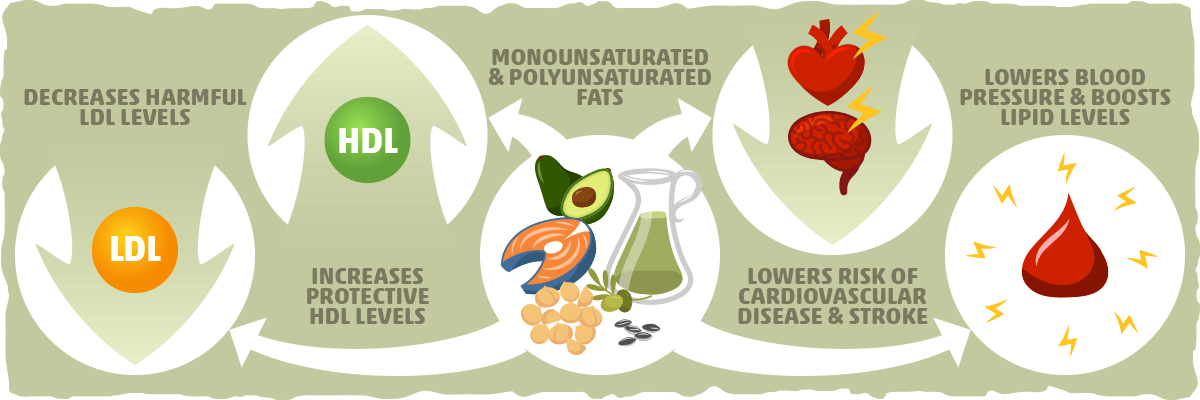
In full general, nearly of the inquiry on unsaturated fats explores the effects of polyunsaturated fats and monounsaturated fats on several mutual heart affliction risk factors. This is especially important considering cardiovascular disease is the number one cause of death worldwide, and information technology is possible to prevent many of these deaths with dietary intervention.
The electric current research literature overwhelmingly suggests that consuming polyunsaturated fats and monounsaturated fats instead of trans fats and saturated fats will lower the take chances of cardiovascular disease and stroke.
A meta-assay of threescore trials likewise indicates that these fats serve as a healthy replacement for some carb intake as well. More specifically, they found that when polyunsaturated and monounsaturated fats were eaten in place of carbohydrates, these healthy fats decreased levels of potentially harmful LDL and increased protective HDL levels.
More recently, the Optimal Macronutrient Intake Trial for Heart Health (OmniHeart) showed that replacing a carbohydrate-rich nutrition with one loftier in unsaturated fatty (predominantly monounsaturated fats) lowers blood pressure, improves lipid levels, and reduces cardiovascular run a risk.
In short, replacing some of our carb, artificial trans fat, and/or saturated fatty intake with polyunsaturated fats and monounsaturated fats can help promote center wellness and reduce the risk of heart disease. This is the primary reason why these fats are typically called "salubrious fats" or "practiced fats."
However, this isn't all these fatty acids have to offer. They take many unique benefits as well.
The Unique Benefits of Polyunsaturated Fats
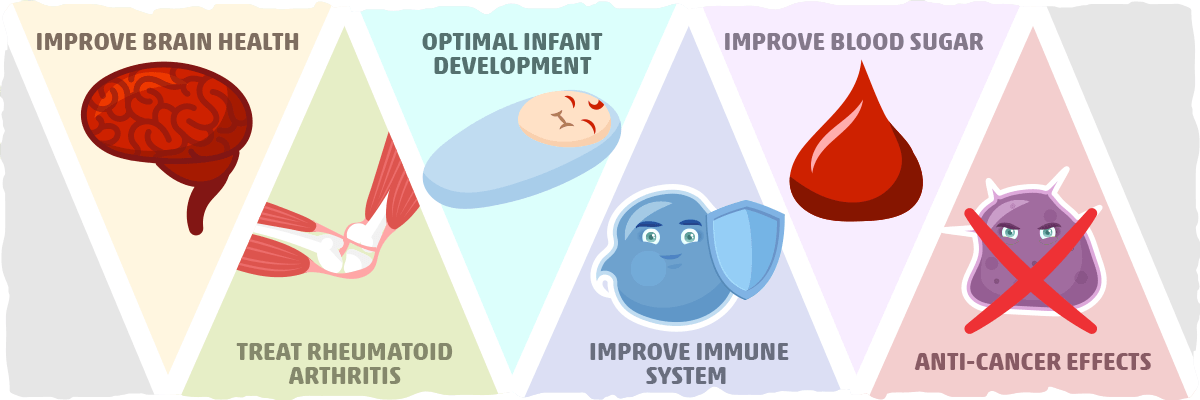
Let'south take a quick look at some of the noteworthy benefits specifically associated with omega-3s and/or omega 6s (the two types of PUFAs):
- Omega-3s may improve overall encephalon wellness. Some studies indicate that specific populations tin can use DHA+EPA (two long-chain omega 3s) to raise cognitive office.
- Omega-3s tin can assistance care for rheumatoid arthritis. EPA + DHA can reduce inflammation, which has been found to be helpful for some patients suffering from rheumatoid arthritis.
- Omega-3s and omega-6s ensure optimal infant development. Sufficient consumption of DHA + EPA and omega-6s during pregnancy can improve infant development and reduce the likelihood of adverse developmental outcomes.
- Omega-6 and omega-3s can help improve immune organisation function. The two types of PUFAs help regulate inflammation, assuasive u.s. to respond to potential threats and tissue damage appropriately. Consuming an acceptable amount of omega-3s and omega-6s will help ensure that our immune system isn't hyperactive or underactive.
- Polyunsaturated fats reduce type 2 diabetes hazard and improve claret carbohydrate regulation. A contempo meta-analysis of randomized controlled feeding trials found that, In comparison to carbohydrates, saturated fats, and monounsaturated fats, PUFAs exert the nigh consequent favorable effects on metrics associated with improved blood sugar levels, insulin resistance, and insulin secretion capacity.
- Omega-3s may have anti-cancer effects. Some research indicates that omega-3s modulate cistron expression in a way that tin impair the proliferation of certain cancers.
For an in-depth breakdown of the inquiry behind these findings, check out our commodity on polyunsaturated fatty acids and their benefits.
The Unique Benefits of Monounsaturated Fats
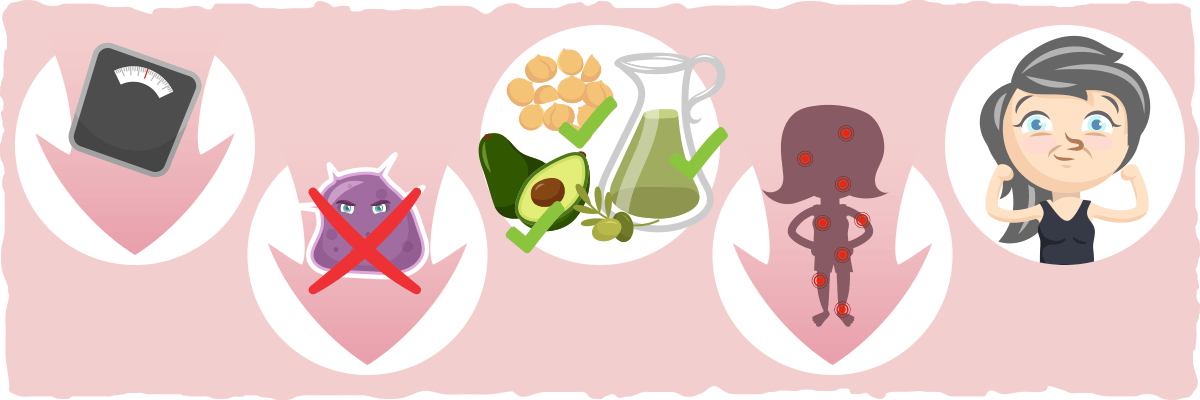
Let's take a quick look at some of the unique benefits specifically associated with MUFAs:
- Increased weight loss. Some evidence suggests that monounsaturated fats tin can promote more fat burning and yield more weight loss when compared to the consumption of saturated fat.
- May reduce the risk of several cancers. MUFA consumption is associated with a reduced run a risk of colon, chest, and prostate cancers. Withal, more enquiry is needed to confirm these correlations and investigate potential mechanisms.
- Reduced inflammation. When compared to other diets, including loftier-saturated-fatty diets and Western diets, high-MUFA diets have been establish to reduce inflammation. 1 written report, for example, found that high-MUFA diets decreased inflammation in patients with metabolic syndrome when compared to those post-obit high-saturated-fat diets.
- Increased longevity. One large observational written report discovered that replacing five% of free energy from saturated fats with the equivalent amount of energy from MUFAs was associated with an estimated 13% reduction in full mortality.
For an in-depth breakdown of the enquiry backside these findings, cheque out our article on monounsaturated fat acids and their benefits.
The Potential Benefits of Natural Trans Fats (CLA)

The effects of conjugated linoleic acids (CLA) are rarely a part of the unsaturated fat acid conversation, but there are ii potential benefits worth noting:
- Increased fat loss. A meta-analysis of CLA studies found that a two m/d dose produces pocket-size body fat loss. When compared with placebo, this translated to roughly 0.two lbs of fatty loss per week.
- May reduce the risk of several diseases. Observational studies betoken that individuals who accept more than CLA in their fat may accept a lower take chances of type 2 diabetes, cardiovascular disease, and certain types of cancer.
As a whole, however, the research on CLA is convoluted and inconclusive. Each blazon of CLA seems to have varying effects on health every bit do different mixtures of CLAs.
Loftier dose supplementation with CLA also seems to cause more damage than good, so it is best to consume CLA from the natural sources yous'll find in the following department.
Unsaturated Fat Food List
We have enough of options to increase our consumption of healthy unsaturated fats. Nuts, seeds, meat, fish, refined nutrient products, and candy oils all can be used to become more MUFAs, PUFAs, and CLA, but not all of them will promote health and vitality.
The inquiry suggests that the healthiest sources of these fats are minimally-processed whole foods and stable cooking fats/oils. Many of these options are as well keto-friendly, which makes them excellent replacements for higher carb foods too.
Hither is a graphical listing of some healthy depression-carb foods that are high in unsaturated fats. To encounter a more detailed, broken downwards department feel gratuitous to gyre beneath the graphic:

Foods loftier in unsaturated fats:
- Avocados. Chock-total of monounsaturated fats, fiber, and micronutrients, avocados can be a versatile staple of any healthy nutrition.
- Nuts, seeds, and peanuts. These fat morsels are mostly made up of unsaturated fatty acids. Some serve a great source of monounsaturated fat, while others are known for their high PUFA content. Nosotros will accept a closer wait at the specifics in the next two subsections.
- Olives. These small fruits derive more of their calories from fat than any other commonly consumed fruit. They also are filled with the wellness-promoting MUFA oleic acid.
- Fatty fish. It crucial to meet our omega-three PUFA needs for optimal health, and eating fatty fish is the nearly efficient mode to do and then. Salmon, mackerel, and sardines are some examples of fatty fish that are both high in DHA+EPA and safe to consume on a weekly footing.
- Duck, chicken, pork, and goose fat. Brute fats incorporate by and large monounsaturated fats and saturated fats with some polyunsaturated fatty acids mixed in. Duck, chicken, pork, and goose fats all incorporate more monounsaturated fatty than whatsoever other type of fat, making them a dandy source of healthy unsaturated fats.
- Beefiness, lamb, and dairy products. These foods represent widely-bachelor natural sources of CLA (natural trans fats) in our diet. Nonetheless, they are relatively low in other unsaturated fats. Opt for pastured-raised, grass-fed products for the most CLA-rich and the healthiest meat and dairy.
Continue in mind, however, that all plants and animals incorporate varying amounts of polyunsaturated and monounsaturated fats. The above list represents those that are particularly high in i, the other, or both.
Yous can likewise benefit from these fats when adding sure fats/oils to your diet. Here is a list of some unsaturated fatty-rich oils/fats with their recommended use for optimal health:
- Olive oil. Olive oil is packed with MUFAs and polyphenols that take been proven to improve health. According to recent research, extra virgin olive oil is best for high-heat cooking.
- Avocado oil. An excellent source of monounsaturated fats that is relatively stable at medium-high heat.
- High oleic sunflower/safflower oil. Both are made from seeds that are naturally selected for high-MUFA content. These oils are likewise the all-time dietary source of oleic acid and are likely to be as stable equally avocado oil.
- Macadamia nut oil. Another cracking source of monounsaturated fatty. Best if used to add together some extra flavor and fatty on meridian of meals, but non equally cooking oil.
- Other vegetable, nut, and seed oils. Most of the oils derived from vegetables, nuts, and seeds are high in polyunsaturated fats. These fats oxidize easily during processing, cooking, baking, and frying, and then information technology is best to utilise these sparingly. Some popular examples of these oils are canola oil, peanut oil, soybean oil, and vegetable oil.
- Duck, chicken, pork, and goose fat. Since these fats are higher in saturated fat, they tend to be more than stable when exposed to rut. They can likewise be used to add together a uniquely satisfying season to your favorite dishes.
For those of you looking to add more of a particular unsaturated fat to your nutrition, take a await at the lists below.
Monounsaturated Fat Foods, Fats, and Oils
The healthiest low-carb and keto-friendly foods with the highest percentage of MUFAs are as follows (with more than 50% of their fat coming from MUFAs):
- Macadamia nuts and homemade macadamia nut butter
- Olives
- Hazelnuts and saccharide-free hazelnut butter
- Avocados
- Almonds and sugar-gratuitous almond butter
- Pecans and sugar-free pecan butter
- Peanuts and saccharide-complimentary peanut butter
Some examples of zip-carb fats/oils rich in monounsaturated fats (with >l% of fat coming from MUFAs) are:
- High-oleic safflower and sunflower oils (best source of oleic acid)
- Actress virgin olive oil (all-time for high-heat cooking)
- Avocado oil
- Macadamia nut oil
- Goose fat
Here are some examples of brute fats that are highest in these fats (~xl-50% of fat coming from MUFAs):
- Goose fat
- Herring
- Duck fat
- Chicken fat
- Lard and other high-fat pork products like bacon
Polyunsaturated Fat Foods and Oils
To ensure optimal PUFA intake, it is best to consume a sufficient amount of omega-3s and omega-6s. This is why our polyunsaturated food list consists of two subcategories.
Best Sources of Omega-3 PUFAs
Arguably the healthiest manner to run across your omega-3 needs is past consuming low-mercury fatty fish.
Here is a list of keto-friendly foods that contain the most DHA and EPA:
- Salmon
- Sardines
- Mackerel
- Rainbow Trout
- Bounding main Bass
And a list of the best sources of Alpha-linolenic acid (ALA):
- Chia seeds
- Walnuts
- Flaxseeds
Still, make sure you are not relying on ALA intake from plants to see your EPA and DHA needs. Most of the benefits of omega-3s come from consuming EPA and DHA direct.
Best Sources of Omega-half-dozen PUFAs
Here is a list of some keto-friendly foods with loftier omega-6 content:
- Walnuts
- Sunflower seeds
- Pine basics
- Mayonnaise (with soybean oil)
- Salary
- Peanuts
- Almonds
- Chicken thighs (with skin)
- Eggs
- Butter
Natural Trans-fat Foods: Sources of CLA
CLAs are non ubiquitous in nature like MUFAs and PUFAs. Since they rely on the fermentation of certain fatty acids in ruminant stomachs, we must look for specific animal products to get some CLA.
Here's a list of the nearly widely available CLA sources:
- High-fatty dairy products (e.g., butter, heavy cream, and cheese)
- Fatty cuts of beef
- Fatty cuts of lamb
Pasture-raised, grass-fed animals tend to have more CLA in their dairy products and meat. Animals raised in this style are also healthier for u.s.a. and the environs, so we recommend opting for pastured-raised, grass-fed beefiness, lamb, and dairy instead of buying the conventionally-raised, grain-fed varieties.
Good for you Unsaturated Fat Recipes
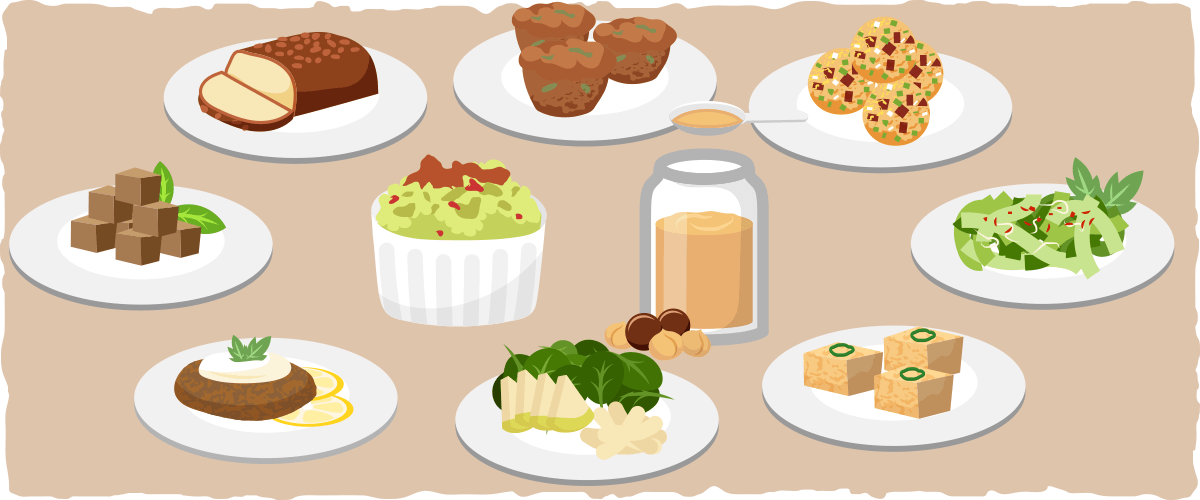
Each one of these recipes is keto-friendly and rich in both PUFAs and MUFAs. If you need aid with increasing your intake of certain types, utilize the food list from above to guide your recipe choices. Feel complimentary to check out our in-depth articles on polyunsaturated fats and monounsaturated fats for more than specific recipes a well.
Low Carb Breakfast Recipes High in Unsaturated Fatty:
- Keto Zucchini Breadstuff with Walnuts
- Salary Avocado Muffins
- Salmon Benny Breakfast Bombs
- Maple Pecan Fat Bomb Bars
Low Carb Luncheon Recipes High in Unsaturated Fat:
- Bacon and Roasted Garlic Guacamole (with pork rinds)
- Five Minute Marinated Feta & Sunday-dried Lycopersicon esculentum Salad
- Sesame Salmon Salad
- Salmon Lettuce Cups with Lemony Basil Spread
Low Carb Snack Recipes High in Unsaturated Fat:
- Homemade Macadamia Nut Butter
- Pecan Butter Chia Seed Blondies
- Smoked Salmon and Caprine animal Cheese Bites
- Almond Butter Chia Squares
Depression Carb Dinner Recipes High in Unsaturated Fat:
- Zucchini Ribbons & Avocado Walnut Pesto
- Sesame Almond Zoodle Bowl
- Creamy Lemon and Dill Pan Seared Salmon
- Cajun Salmon Cakes
Low Carb Sides that are High in Unsaturated Fat:
- Spinach Watercress Keto Salad
- Jalapeno Cornbread Mini Loaves
- Keto Mushroom Wild Rice Pilaf
- Raspberry Pecan Salad
Depression Carb Dessert Recipes High in Unsaturated Fatty:
- Speculoos and Macadamia Biscotti
- Keto Chocolate Peanut Butter Tarts
- Mini Pumpkin Spice Muffins
- Chocolate Chunk Avocado Ice Foam
How Much Unsaturated Fat Should You Eat for Optimal Health?
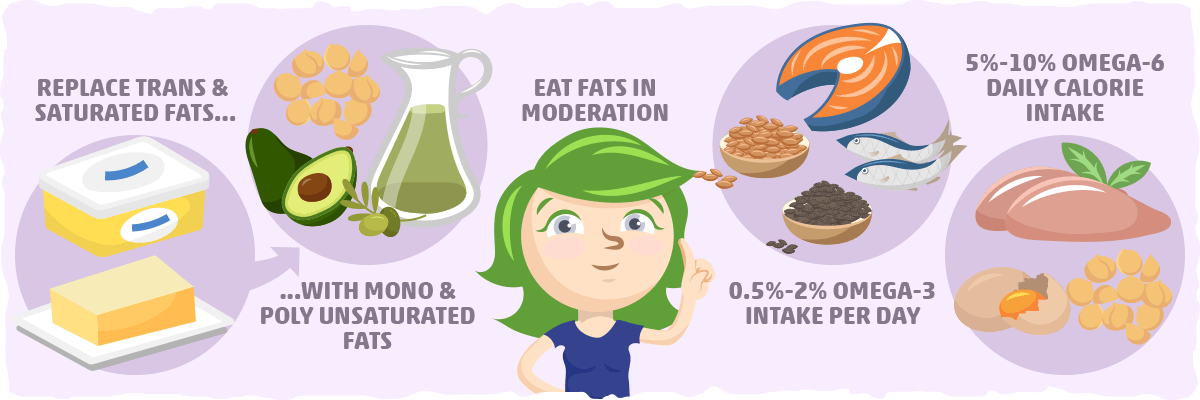
There is no universally optimal intake level of polyunsaturated fatty, monounsaturated fatty, or CLA. The only unsaturated fatty that has whatsoever specific quantity attached to it is artificial trans fatty – and that optimal intake level is nothing grams.
The general recommendation is to supervene upon all artificial trans fats and some saturated fats with polyunsaturated fats and monounsaturated fats. Research besides suggests that substituting healthy fats for high-carb foods is a great way to meliorate health also.
That beingness said, there is an intake limit to these fats for optimal health. Consuming nigh of your fat from omega-3s and omega-6s, for example, may not exist prudent, given the potential for oxidation and the lack of enquiry supporting excessive PUFA intake.
When it comes to polyunsaturated fat intake, getting the right amount of omega-6s and omega-3s is crucial.
The Globe Health Organization recommends an omega-3 fatty acid intake of 0.5–2% of free energy per day. The American Heart Association specifically recommends that we get at least two servings of fatty fish per week or 500 mg EPA + DHA per mean solar day.
Regarding omega-6 intake, a recent analysis conducted past the American Heart Association emphasizes the importance of consuming at least five-10% of daily calories from omega-6 fatty acids.
Altogether, these recommended intakes represent the estimated corporeality of omega-half-dozen and omega-3 we demand for optimal health. The healthiest way to encounter these needs is by replacing heavily processed foods and oils with the nutrient-rich foods and recipes that we learned about previously.
In contrast to PUFAs, y'all can only go wrong with MUFA consumption if y'all eat so much of them that it leads to fatty gain. As long as you are eating the right amount of calories to achieve your goals and meeting your other nutritional needs with healthy foods, experience free get equally many of those calories from MUFA-rich foods, fats, and oils as you'd like.
CLA intake follows like logic merely should not exist prioritized over PUFA and MUFA consumption. Grass-fed high-fatty dairy, beef, lamb, and meat from other ruminants should serve as the only sources CLA because they don't come up with the health risks of higher supplemental doses and provide us with other beneficial nutrients.
The Potential Harms of Unsaturated Fatty Acids
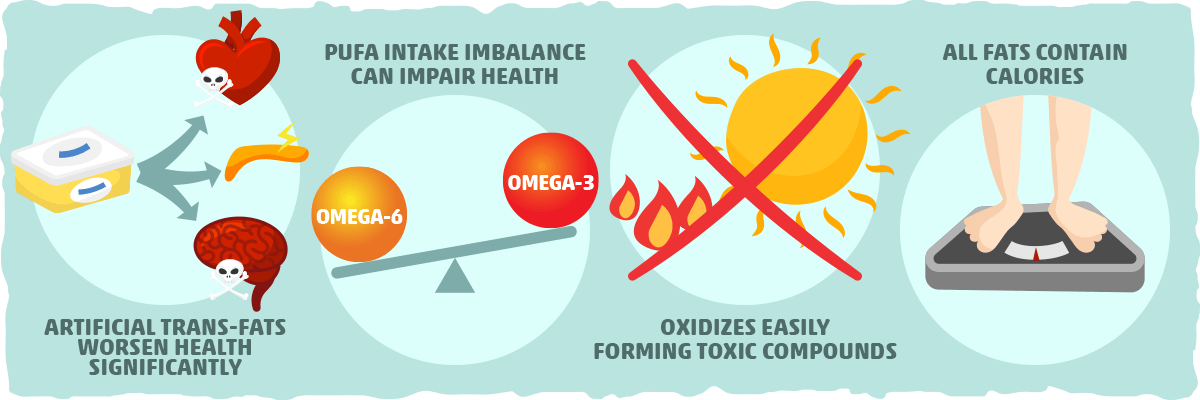
Although unsaturated fats tin can confer unique and significant wellness benefits when compared to saturated fatty and carbs, they do have a dark side. Nosotros hinted at the four harms of these fats throughout this article, but it is crucial that we state them explicitly. Nosotros will start with the most obvious:
Artificial Trans Fats Worsen Health Significantly
Artificial trans fats are – without a doubt – the worst blazon of fat for overall health because they:
- Heighten LDL and lower HDL levels.
- Create chronic inflammation, which is associated with centre disease, stroke, diabetes, and other chronic weather condition.
- Contribute to insulin resistance and type 2 diabetes.
- Even small amounts have a substantial impact on our health. 1 meta-analysis constitute that, for every two percent increment of calories consumed from trans fat daily, the run a risk of coronary heart disease increases past 23%.
In other words, these fats tin can potentially reverse all of the positive wellness progress you make by eating healthy fats.
In light of these findings, there are no safe levels of trans fat to swallow each day. Keeping our daily intake every bit low equally possible is crucial for optimal health.
To practice this, nosotros must avoid products that comprise whatever type of partially hydrogenated oil – even if the characterization claims information technology has no trans fatty.
Partially hydrogenated oils are ordinarily plant in the following products:
- margarine
- vegetable shortening
- packaged snacks
- premade broiled goods
- ready-to-use dough
- fried foods
- java creamers, both dairy and nondairy
Imbalanced PUFA Intake Tin Impair Wellness
Health issues typically arise when we are non consuming enough or eating too much of either PUFA. Science shows that it's crucial to get the proper amount of omega-3 fatty acids and omega-six fatty acids from nutrient-rich sources such every bit fat fish, nuts, seeds, eggs, and fresh meat.
This simple strategy will ensure that y'all go the benefits you expect from PUFAs. Plus, past consuming nutrient-rich whole foods, you tin assist mitigate the third potential harm of these frail fats.
Some Unsaturated Fats can Oxidize Easily and Form Toxic Compounds
Carbon-carbon double bonds increment the instability of the fatty acid. As a result, monounsaturated and polyunsaturated fats both are vulnerable to oxidation when exposed to excess air, light, and heat.
Once these fats oxidize, they form harmful compounds that are toxic to the body and rob us of the health benefits that we wait from these fats.
Polyunsaturated fats are the most vulnerable to oxidation because of their multiple double bonds, while MUFAs are typically able to sustain higher temperatures with less oxidation.
Research also suggests that CLA may be even more than vulnerable than certain types of polyunsaturated fatty acids every bit well.
Because of this, both high-PUFA and CLA-rich foods/fats/oils should be stored in a cool dark identify and prepared using depression cooking temperatures. This volition aid minimize the harm and maximize the benefits of these unsaturated fats.
All Fats Contain Calories
Just considering they are known as good for you fats doesn't mean you should consume equally much as possible. All fats, including unsaturated fat acids, contain roughly 9 calories per gram — more than twice the calories establish in carbs and protein.
If you're not careful with your consumption of these fats, you might exceed your calorie needs and proceeds fatty. This is why it is crucial to follow the strategy we laid out before – i.e., replace all of your trans fat and some of your saturated fat and carb intake with healthy unsaturated fats.
Putting It All Together — Everything You Need to Know About Unsaturated Fat
At that place are four types of unsaturated fat establish in our diets:
- Polyunsaturated fat (PUFAs) – fat acids that contain more than i carbon-carbon double bond.
- Monounsaturated fat (MUFAs) – fatty acids that contain only 1 carbon-carbon double bond.
- Natural trans-unsaturated fat acids – fatty acids found in ruminant milk and fat that take at to the lowest degree i trans-double bond and one cis-double bond. They are commonly known equally conjugated linoleic acids (CLA).
- Artificial trans-unsaturated fatty acids – fatty acids with no cis-double bonds and at to the lowest degree 1 trans-double bond, created artificially via a process called hydrogenation.
PUFAs and MUFAs are known as the "healthy" fats because they improve wellness more than effectively than whatever other types of fat. These fats do good u.s. nearly when we supercede all of our trans fatty and some of our saturated fat and carb intake with healthy unsaturated fat foods.
The enquiry on natural trans-unsaturated fatty acid is not equally conclusive. They can help increment fat loss by a small-scale amount but may not benefit overall health.
All in all, the research literature suggests that the healthiest arroyo to fatty intake is to eat plenty of minimally processed whole foods and stable cooking fats/oils that are high in PUFAs and/or MUFAs. Many of these options are also keto-friendly, which makes them keen replacements for carb-heavy foods.
Some of the best unsaturated fat food choices are as follows:
- Avocados
- Nuts, seeds, and peanuts
- Olives
- Fatty fish such every bit sardines, salmon, and mackerel
- Duck, chicken, pork, and goose
- Beef, lamb, and high-fatty dairy products (for CLA)
You can besides do good from these fats when adding certain fats/oils to your nutrition. Hither is a listing of some healthy unsaturated fatty-rich options:
- Olive oil (best for high-heat cooking)
- Avocado oil
- High oleic sunflower/safflower oil
- Macadamia nut oil
- Duck, craven, pork, and goose fat
Go on in mind that all plants and animals contain varying amounts of polyunsaturated fat and monounsaturated fatty. The above listing represents those that are peculiarly loftier in i, the other, or both.
Hither are some examples of keto-friendly recipes that incorporate many of these healthy fat-packed ingredients:
For breakfast:
- Keto Zucchini Bread with Walnuts
- Bacon Avocado Muffins
- Salmon Benny Breakfast Bombs
- Maple Pecan Fatty Bomb Bars
For lunch:
- Salary and Roasted Garlic Guacamole (with pork rinds)
- Five Minute Marinated Feta & Sun-dried Love apple Salad
- Sesame Salmon Salad
- Salmon Lettuce Cups with Lemony Basil Spread
For a snack:
- Homemade Macadamia Nut Butter
- Pecan Butter Chia Seed Blondies
- Smoked Salmon and Goat Cheese Bites
- Almond Butter Chia Squares
For dinner:
- Zucchini Ribbons & Avocado Walnut Pesto
- Sesame Almond Zoodle Bowl
- Flossy Lemon and Dill Pan Seared Salmon
- Cajun Salmon Cakes
As a side:
- Spinach Watercress Keto Salad
- Jalapeno Cornbread Mini Loaves
- Keto Mushroom Wild Rice Pilaf
- Raspberry Pecan Salad
For dessert:
- Speculoos and Macadamia Biscotti
- Keto Chocolate Peanut Butter Tarts
- Mini Pumpkin Spice Muffins
- Chocolate Chunk Avocado Ice Foam
If y'all'd similar to learn more about the different types of fats constitute in these recipes, feel free to read the following resource:
- Polyunsaturated Fats
- Essential Fatty Acids: Omega 3 and Omega half dozen
- Monounsaturated Fats
For more practical information on how to lose weight and improve health with a depression-carb diet, cheque out our beginner's guide to keto, or take a look at our resources beneath:
- The Importance of Fats on the Keto Nutrition
- The Different Types of Fats
- The impact of a keto diet and diabetes
Sources
- Unsaturated fatty – Scientific discipline Daily
- nine-Octadecenoic acid – NCBI
- Why Are Trans Fats Bad for You? The Disturbing Truth – Healthline
- Chemical Characteristics – Olive Oil Source
- Essential Fat Acids – Oregon State University
- Pros and cons of CLA consumption: an insight from clinical evidences – NCBI
- Effects of dietary fatty acids and carbohydrates on the ratio of serum full to HDL cholesterol and on serum lipids and apolipoproteins: a meta-analysis of 60 controlled trials. – NCBI
- Effects of protein, monounsaturated fat, and carbohydrate intake on blood pressure and serum lipids: results of the OmniHeart randomized trial. – NCBI
- Characteristics of the Diet Patterns Tested in the Optimal Macronutrient Intake Trial to Prevent Heart Illness (OmniHeart): Options for a Heart-Healthy Diet – NCBI
- Efficacy of conjugated linoleic acid for reducing fat mass: a meta-analysis in humans – The American Journal of Clinical Diet
- Conjugated linoleic acid supplementation, insulin sensitivity, and lipoprotein metabolism in patients with type ii diabetes mellitus – The American Journal of Clinical Nutrition
- Dietary conjugated linoleic acid and long-chain north-iii fat acids in mammary and prostate cancer protection: a review. – NCBI
- CLA (Conjugated Linoleic Acid): A Detailed Review – Healthline
- Essential Fat Acids: Omega 3 and Omega 6 – Ruled.me
- Factors affecting conjugated linoleic acid content in milk and meat. – NCBI
- Conjugated linoleic acid content of milk from cows fed different diets. – NCBI
- Evaluation of Chemical and Physical Changes in Dissimilar Commercial Oils during Heating – Acta Scientific Nutritional Wellness
- Conjugated Linoleic Acrid and Dietary Beef – Beef Facts
- Oxidation of a functional, CLA-rich oil: determination of volatile and non-volatile compounds – European Food Research and Applied science
- Oxidative stability of conjugated linoleic acids relative to other polyunsaturated fat acids – Journal of the American Oil Chemists' Society
- Trans fatty acids, insulin resistance, and type ii diabetes. – NCBI
- Trans fatty acids and coronary heart disease – NCBI
Source: https://www.ruled.me/what-is-unsaturated-fat/